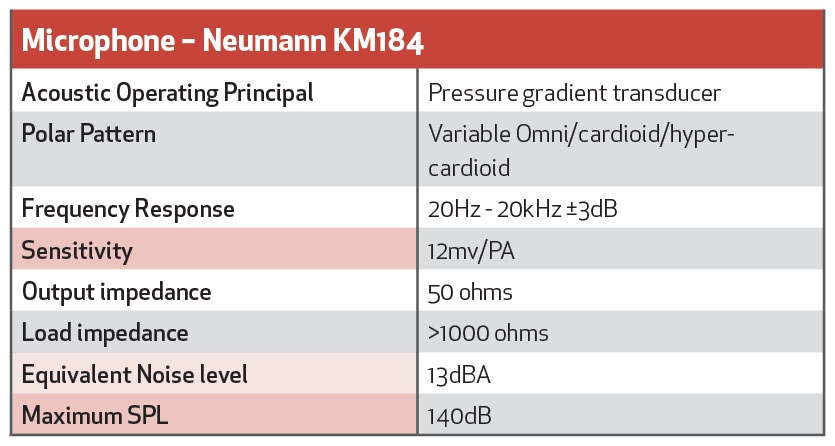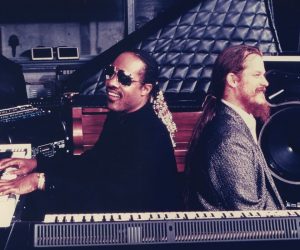
Coach Hugh: The Matchmaker
Matching microphones with the right preamp is not as hard as it looks, especially with our online calculator.
Tutorial: Hugh Covill
One of the many hats I wear is owner of a small cottage microphone business. Part of the business’ value proposition is that I have a personal conversation with all of my customers. One common line of questioning surfaces half a dozen times a week centred around ‘Which preamp do you recommend?’
On one hand, there are completely subjective answers to that question; pulling together preferences for sound, quality, tone, etc. With thousands of microphone preamps ranging in price from under $100 to over $10k a channel, there’s no common price-to-performance formula you can follow to help make that decision.
However, you can compare technical specifications of preamps and microphones to find out whether they match well. This ‘no maths required’ primer is your Babel fish for translating the seemingly foreign languages used by manufacturers to describe their preamps and mics.
FISHING FOR COMPLEMENTS
Technical specifications between preamps and microphones don’t ‘speak’ the same language. Microphones use SPL as a key descriptor while preamps use volts. Before we stick a fish in our ear and swallow some specs, let’s define what’s most important to ascertain:
Is there a chance the microphone output can overload the
preamp’s input?
Both the preamp and the microphone will have a self noise specification. Will the preamp add noise to the microphone’s performance?
Will the preamp supply enough gain?
Now let’s look at an abridged microphone and preamp specification side by side, identify the key information required to answer the above questions and explain the terms involved.
GLOSSING OVER THE DETAIL
First, let’s scan through the microphone’s technical data.
Operating principal states the type of microphone transducer — i.e. ribbon, condenser, dynamic, etc.
Polar pattern describes the directional character of the microphone. An omni-directional microphone has a theoretically spherical pickup pattern around the microphone at all frequencies whereas a cardioid exhibits good rear rejection. The microphone manufacturer will typically provide 2D polar plots to demonstrate the 3D directional character of the microphone. Something to bear in mind is that (like most measurements in audio) polar response is frequency dependent.
Frequency response refers to the range of frequencies reproduced for a given amplitude (level) variation (usually ±3dB). The microphone may well pickup/reproduce a much wider range of frequencies than this but typically they will be at a much reduced level. The microphone manufacturer will typically provide a Level vs. Frequency graph that illustrates the frequency response.
Sensitivity is one of the key means of understanding a microphone’s compatibility with preamps. A microphone converts sound pressure fluctuations into very small ‘mic level’ voltages in the millivolt range. Sensitivity is the least ambiguous microphone specification because it is governed by a standard. The standard is to apply a 1kHz sine wave at 94dB SPL (one Pascal), then measure the output level voltage and express it in millivolts per Pascal (mV/PA). To express it another way, if you apply one Pascal (94dB SPL) of pressure to the microphone it will produce 20mV, so the sensitivity of the microphone is 20mV/PA. Once you measure a voltage, this can be expressed as a decibel by calculating the change in voltage between 20mV and .775V (the voltage referenced as 0 on the dBu scale). The result is -32dBu, meaning the microphone’s sensitivity can be expressed as either 20mV/PA or -32dBu. Some manufacturers express sensitivity in dBu, others mV/PA, while some provide both. Microphone sensitivity is expressed in negative dB units because the voltages of mic level signals are all well below the 0dBu reference voltage. Rule of thumb: Sensitivity trends downwards the further the dB value falls into negative territory.
Impedance is beyond the scope of this primer. However, almost all modern audio systems use what is often termed a ‘voltage matching’ topology comprising low impedance outputs and high impedance inputs (sometimes called bridging inputs). The rule of thumb is the input impedance is a factor of 10 — i.e. 10 times the output impedance. Without muddying the waters, this method allows for (almost) no change in voltage from output to input. Typically microphone output impedances will be low, <200Ω nominally is typical.
Equivalent Noise Level is the self noise of the microphone, essentially the microphone’s noise floor. It is defined as the SPL that will create the same voltage as the self-noise the microphone will produce. It’s usually expressed in dB SPL (A weighted); you want this to be low especially for recording quiet sources. Anything under around 18dB (A) is a good number.


Maximum SPL defines the highest SPL the microphone can handle before the signal becomes distorted. Put another way, it’s the maximum acoustic input the microphone can handle before the voltage produced becomes distorted. It’s usually expressed as a dB SPL @ .5% THD (total harmonic distortion). This just means the point where the distortion can be measured, not heard. Beware specs without a specified THD; they’re meaningless. Also be aware that some manufacturers will use higher THD — 1% or more — to yield a higher maximum SPL. Some manufacturers will provide both the SPL level where .5% THD occurs but also the point at which the signal from the microphone will actually clip (becomes a square wave).
On the Preamp side, expect to see these specifications.
Gain is the amount your signal level can be increased. If you are working with mics that have low sensitivity such as ribbons, you’ll need more gain. Passive ribbon designs might exhibit a sensitivity of -50dBu. In that case, you’ll need 50dB of gain just to amplify the signal back to 0dBu. Ideally 65-70dB of gain (above the noise floor) will be required to comfortably amplify this signal remembering that running the gain pot at maximum results in maximum noise. Bear in mind this is the worst case scenario. The gain required to amplify a signal is dependent on how loud that signal is acoustically. You’re not going to need a huge amount of gain for a drum kit or guitar cab as the microphone is converting the high acoustic SPL into a similarly high voltage. A gentle classical guitar piece, however, might need scads of gain.
Equivalent Input Noise (EIN) is a measure of how much noise the microphone preamp is adding to the microphone’s signal. It’s measured at output with a dummy load on the input (150Ω resistor) and the gain at full (bandwidth specified). Good numbers are around -122dBu to -130dBu. As EIN is input and gain related you can clearly see the relationship between noise floor and cranking the gain. Take the above example of the ribbon microphone with a sensitivity of -50dBu. If the preamp EIN is -130dBu then you have 80dB of signal-to-noise at the preamp input and cranking the gain from here increases the signal and noise proportionally. It’s important to note that EIN is an un-weighted measurement – more on this later.
Maximum Input Level & Maximum Output Level are simply the maximum signal level in dBu where the signal goes into distortion (clipping). The maximum input level is of particularly interest when matching microphones to preamps — you don’t want your microphone to comfortably produce a voltage that clips the preamp input!
MAKING SENSE OF SENSITIVITY
Okay, so now that we have defined what all the various technical specifications mean let’s apply them to matching a microphone with a preamp. In table one I have highlighted the key descriptors in red. There are two key things that we can determine from the specifications.
Will the microphones Max SPL number generate a voltage at the preamp input that will clip the signal? And, will the inherent noise of the preamp add to and degrade the microphone’s signal once it’s connected to the preamp?
Delivering on my ‘no maths’ promise I’ve created an online calculator which means you just need to connect to the inter-web and input some numbers listed on your product specifications sheets, saving you the pain of staring absentmindedly at a 20*log equation!
Firstly, the calculator allows you to convert mV/Pa to dBu — just punch the number from your microphone specifications sheet into either input area to view the conversion.
Next, input your microphone’s Max SPL and Mic Sensitivity (from the spec or previous conversion) and the calculator will tell you the maximum voltage produced at the microphone’s output, which will be the maximum voltage it can present to the preamp’s input. Compare this with the preamp’s Maximum Input Level to determine whether the preamp can accommodate this level.
Let’s have a quick look at the specification table and input those numbers into the calculator. The Neumann KM184 lists a Max SPL of 140dB SPL with a sensitivity of 12mV/PA, which when inputted into the calculator yields almost +10dBu. The API preamp lists a Maximum Input Level of +8dBu, so in the worst case scenario the KM184 will be overloading the preamp input by a whole 2dBu. Bear in mind this is the worst case scenario. If the sources you are likely to record are significantly lower level then you most probably should be fine. However, if you intend to record rock drummers and searing electric guitars then you may well want to consider a preamp with a bit more headroom.
Lastly, you can enter the microphones ENL and Sensitivity and it will yield the microphone’s self-noise level in dBu. You can then compare this number with the preamps EIN. The numbers from out table lists the KM184 as having an ENL of 13dBA and a sensitivity of 12mV/PA, which yields a self-noise of -117dBu. The API preamp lists its EIN as being -129dBu so it’s not adding any noise to the mic’s performance. It’s actually a little more complex than this (the ENL is an A weighted measure) but as a rule of thumb try for a preamp’s noise floor 6-10dB below the microphone’s self-noise.
WRAP UP
Audio engineering is a balancing act between art and science. This primer looks at the science side of the equation. On the art side of the equation your ears are the great arbiter. They determine whether a piece of gear, or combination sounds good. A technical specification won’t tell you that. This ‘no maths’ primer on comparing the compatibility of specific microphones and preamps is a good ball-parking tool for the science side of the scales. Just use the online calculator to make comparisons.
As with most of my primers, I’ve skated over complex detail in pursuit of the bigger picture. There are myriad ways manufacturers can skew the figures and the detail is often in what is not included. Many premium microphone manufacturers will provide very detailed specifications that quantify how the measurement was performed. Something like EIN 125dBu, 20kHz bandwidth, maximum gain under 150Ω load is best practise. At the other end of the spectrum you’ll see numbers specified without any quantification, like EIN 125dB. Numbers without any quantification provide less reputable manufacturers with plenty of wriggle room to massage the results. EIN for example will yield quite different results for different gain settings. I’ve left out dynamic mics which often won’t specify noise at all (SM58 as an example) because it is inherently really low and linked to impedance. There is no standard for specifications and you’ll often see dBV referenced — but you can easily do the dBu to dBV quick-step (dBV = dBu + 2.2, see my last Issue 104 primer on the decibel). Caveats aside, I hope you find the specification Babel fish useful.
















Where’s the calculator?